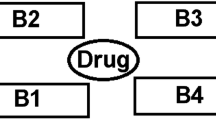Abstract
In this work, molecular modeling methods have been applied to the interaction characterization of polypyridyl transitional-metal complexes with the oligonucleotide (B-DNA fragment). In order to explore the factors governing the groove recognition and intercalative depth, we establish a simple and practical docking method (step-by-step docking operation) to obtain potential curves while making complexes inset into B-DNA along an assigned path. Energy values in the potential curve are obtained from energy minimization of binding geometries. Modeling results clearly show that the optimum binding conformation corresponding to the global minimum in the potential curve for each complex is found to correlate well with the experimental results. Our results also confirm that minor changes of the ligand structure can lead to profound influences on binding geometries, so the molecular shape of the complexes is a predominant factor in governing the binding mode. Moreover, we find that the vdW force and “water molecular effect” are strongly associated with molecular-shape selection in our model. These results complement and extend the knowledge of the nature of these complexes binding to B-DNA.
Figure Schematic illustration of metal complexes bound to B-DNA. The complexes are intercalated into the A5T6/T6A5 base step via a “head-on” fashion










Similar content being viewed by others
References
Sitlani A, Long EC, Pyle AM, Barton JK (1992) J Am Chem Soc 114:2303-2312
Arounaguiri S, Maiya BG (1996) Inorg Chem 35:4267–4270
Lincoln P, Norden B (1998) J Phys Chem B 102:9583-9594
Terbrueggen RH, Johann TW, Barton JK (1998) Inorg Chem 37:6874-6883
Holmlin RE, Yao JA, Barton JK (1999) Inorg Chem 38:174-189
Patterson BT, Collins JG, Foley FM, Keene FR (2002) J Chem Soc Dalton Trans 4343–4350
Wilhelmsson LM, Esbjo1rner EK, Westerlund F, Norden B, Lincoln P (2003) J Phys Chem B 107:11784–11793
Holmlin RE, Steamp EDA, Barton JK (1998) Inorg Chem 37:29-34
Tuite E, Lincoln P, Norden B (1997) J Am Chem Soc 119:239-240
Han DX, Yang P (2000) Sci Chin B 43:516–523
Yang P, Han DX, Xiong ZH (2001) J Mol Struct (Theochem) 540:211–219
HyperChem, Release 6.0 (2000) Hypercube Inc
Lane AN, Jenkins TC, Brown T, Neidle S (1991) Biochemistry 30:1372–1385
Watts CR, Kerwin SM, Kenyon GL, Kuntz ID, Kallick DA (1995) J Am Chem Soc 117:9941-9950
Frankjin CA, Fry JV, Collins JG (1996) Inorg Chem 35:7541-7545
Dupureur CM, Barton JK (1997) Inorg Chem 36:33-43
Marques HM, Warden C, Monye M, Shongwe MS, Brown KL (1998) Inorg Chem 37:2578-2581
Collins JG, Sleeman AD, Janice RAW, Greguric I, Hambley TW (1998) Inorg Chem 37:3133-3141
Erkkila KE, Odom DT, Barton JK (1999) Chem Rev 99:2777-2795
Ihtshamul H, Lincoln P, Suh D, Norden B, Chaires JB (1995) J Am Chem Soc 117:4788-4796
Linclon P, Broo A, Norden B (1996) J Am Chem Soc 118:2644-2653
Greguric I, Aldrich-Wright JR, Collins JG (1997) J Am Chem Soc 119:3621-3622
Campisi D, Marii T, Barton JK (1994) Biochemistry 33:4130-4139
Hudson BP, Barton JK (1998) J Am Chem Soc 120:6877–6888
Brandt P, Norrby T, Akermark B (1998) Inorg Chem 37:4120-4127
Acknowledgments
The authors acknowledge the support of Provincial Education Science Foundation of GuangDong (Series Number: 0164).
Author information
Authors and Affiliations
Corresponding author
Rights and permissions
About this article
Cite this article
Han, D., Wang, H. & Ren, N. Molecular modeling of B-DNA site recognition by Ru intercalators: molecular shape selection. J Mol Model 10, 216–222 (2004). https://doi.org/10.1007/s00894-004-0191-z
Received:
Accepted:
Published:
Issue Date:
DOI: https://doi.org/10.1007/s00894-004-0191-z




